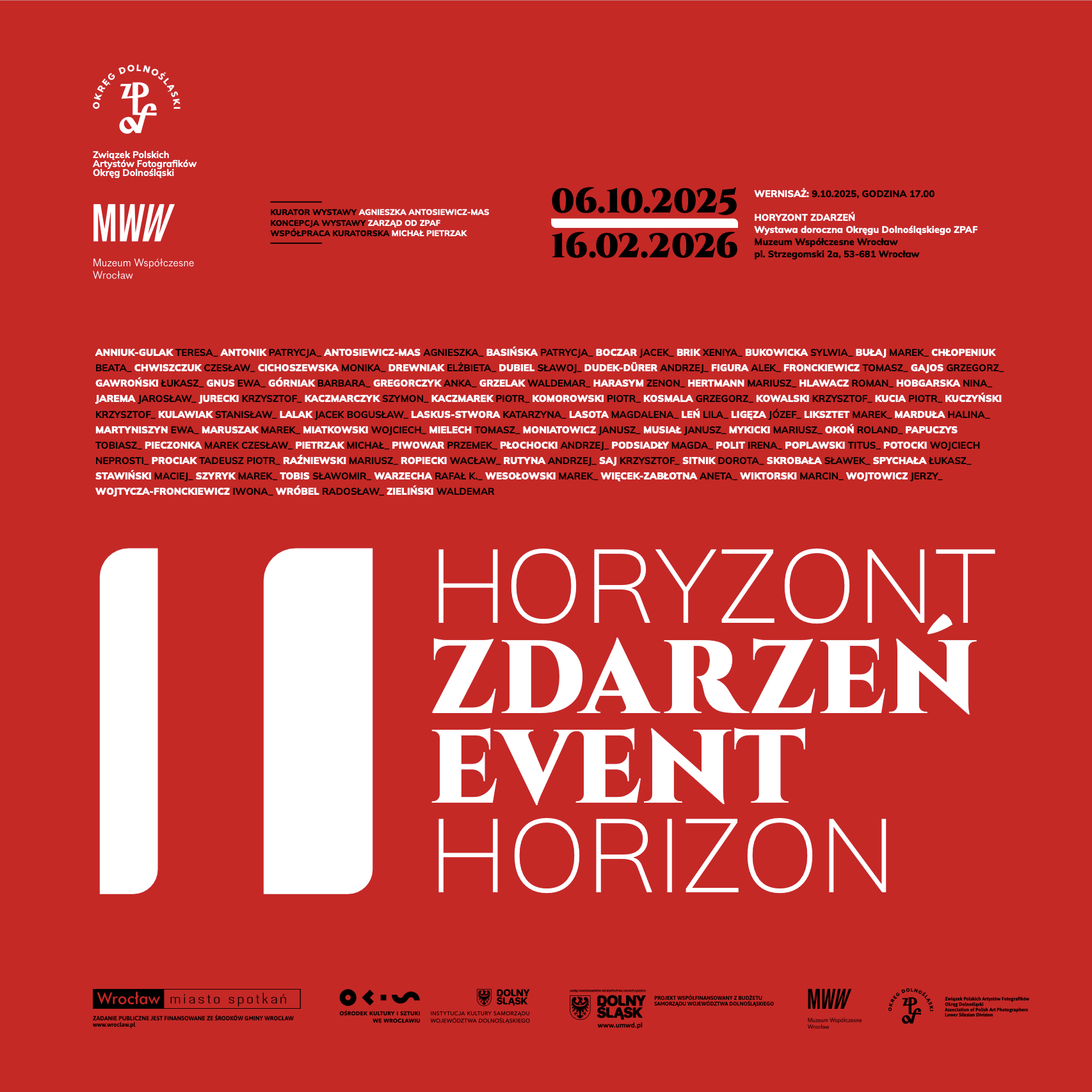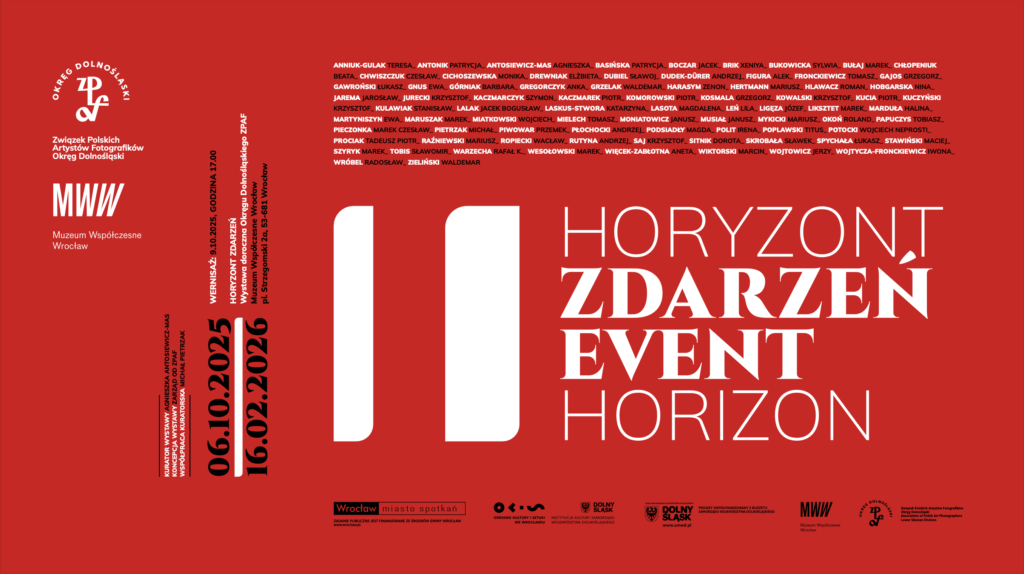[opening: 09/10/2025 at 17:00 • LEVEL 3 MWW]
The concept of the event horizon derives from the description of phenomena accompanying the cosmological phenomenon known as a black hole. The event horizon marks a boundary from beyond which nothing—neither matter nor light—returns. It is a realm of absolute irreversibility, a singularity, a place where space-time collapses, and our tools of cognition prove inadequate. The event horizon is a boundary against which all certainty falls silent. Metaphorically, the idea of the event horizon transcends cosmology. In human experience, it describes a certain state of existence: a point of contact with the inexpressible, the inscrutable, defying definition or even prediction. In this context, being—as Heidegger argued—is not something self-evident; it is rather that which eludes. However, a person who understands their existence constantly gazes toward its end, toward nothingness. This gaze, though filled with fear, harbors hope for deeper understanding at the boundary between the visible and the unimaginable, where light halts its course and time loses meaning. Where, perhaps, a premonition of the meaning of human existence is born.
Photography particularly addresses the idea of liminality. In The Light of the Image, Roland Barthes wrote about photography as a medium of death. The image always indicates the past, simultaneously announcing and confirming absence. This simple yet inevitable foundation of photography makes it a liminal space, a meeting point between presence and absence. At the same time, photography—especially one that contains a punctum, a personal wound, a piercing gaze—can be a place where being reveals itself most fully. Looking at a photograph, we essentially touch upon what Barthes called proof of the existence of a world that does not, after all, disappear with the transient order of human perception. Every photograph is a trace of being and light that have touched reality. However, there are photographs that become more than just a recording. They ask for a new perspective and the expansion of the field of interpretation. In their presence, we experience the fragility of existence, yet at the same time, we touch upon the impenetrable. Such images not only become objects of aesthetic contemplation or a place of encounter with one's own finitude, but – paradoxically – they offer hope for transcending it.
The event horizon is a concept whose purpose is not to describe the world but to confront us with its ineffable depths. It is not an illustration of reality, but an attempt to reveal what Heidegger called the truth of being. aletheia – what is revealed when we lift the veil of everyday life. Representations of this idea speak to the vulnerability of existence in the face of time and emptiness. However, they are not devoid of hope – on the contrary, their silence conceals a tenderness towards being, which, though transient, remains unforgettable. The human event horizon, like a black hole, absorbs questions, reflects fears, and bends the space-time continuum of our perception. It offers no solace. It does not construct a narrative, but a space for experience – for presence and absence, for light and shadow, for a question that demands not an answer but shared silence.
I am convinced that the artistic proposals submitted by the participants in this year's exhibition touch upon the issues outlined above. The multitude of topics and aesthetics presented once again demonstrates that photography is an exceptionally effective medium for describing and interpreting not only what is visually visible and objective, but also what is unique, hermetic, hidden within us, and above all, worthy of being noticed.
Curator Agnieszka Antosiewicz-Mas
Participants of the exhibition:
Teresa Anniuk-Gulak / Patrycja Antonik / Agnieszka Antosiewicz-Mas / Patrycja Basińska / Jacek Boczar / Xeniya Brik / Sylwia Bukowicka / Marek Bułaj / Beata Chłopeniuk / Czesław Chwiszczuk / Monika Cichoszewska / Elżbieta Drewniak / Sławoj Dubiel / Andrzej Dudek-Dürer / Alek Figura / Tomasz Fronckiewicz / Grzegorz Gajos / Łukasz Gawroński / Ewa Gnus / Barbara Górniak / Anka Gregorczyk / Waldemar Grzelak / Zenon Harasym / Mariusz Hertmann / Roman Hlawacz / Nina Hobgarska / Jarosław Jarema / Krzysztof Jurecki / Szymon Kaczmarczyk / Piotr Kaczmarek / Piotr Komorowski / Grzegorz Kosmala / Krzysztof Kowalski / Piotr Kucia / Krzysztof Kuczyński / Stanisław Kulawiak / Jacek Bogusław Lalak / Katarzyna Laskus-Stwora / Magdalena Lasota / Lila Leń / Józef Ligęza / Marek Liksztet / Halina Marduła / Ewa Martyniszyn / Marek Maruszak / Wojciech Miatkowski / Tomasz Mielech / Janusz Moniatowicz / Janusz Musiał Mariusz Mykicki / Roland Okoń / Tobiasz Papuczys / Marek Czesław Pieczonka / Michał Pietrzak / Przemek Piwowar / Andrzej Płochocki / Magda Podsiadły / Irena Polit / Titus Poplawski / Wojciech Neprosti Potocki / Tadeusz Piotr Prociak / Mariusz Raźniewski / Wacław Ropiecki / Andrzej Rutyna / Krzysztof Saj / Dorota Sitnik / Sławek Skrobała / Łukasz Spychała / Maciej Stawiński / Marek Szyryk / Sławomir Tobis / Rafał K. Warzecha / Marek Wesołowski / Aneta Więcek-Zabłotna / Marcin Wiktorski / Jerzy Wojtowicz / Iwona Wojtycza-Fronckiewicz / Radosław Wróbel / Waldemar Zieliński



